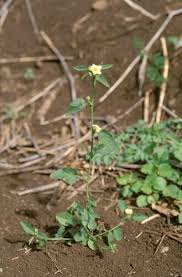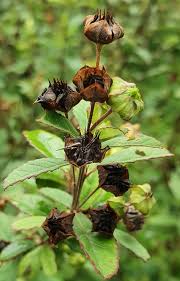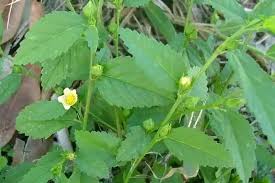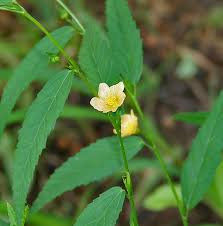How to Grow Sida Acuta is a journey into cultivating a versatile and resilient plant that offers numerous benefits. Commonly known as the “wireweed” or “sida,” Sida Acuta is a perennial herb native to tropical and subtropical regions. It thrives in various soil types and environmental conditions, making it an excellent choice for both home gardeners and agricultural purposes.
This hardy plant can reach heights of up to 1.5 meters and features slender, upright stems with green, serrated leaves that contribute to its unique aesthetic appeal. Besides its ornamental value, Sida Acuta is renowned for its medicinal properties, making it a valuable addition to any garden.
One of the primary reasons for growing Sida Acuta is its medicinal uses. Traditionally, different parts of the plant have been utilized in herbal medicine to treat various ailments. It is believed to have anti-inflammatory, analgesic, and antimicrobial properties, making it a popular choice in natural remedies.
The leaves can be brewed into teas or used in poultices, while the roots are often employed in various traditional medicines. As awareness of natural healing methods grows, the demand for plants like Sida Acuta continues to increase, presenting a unique opportunity for gardeners and herbalists alike.
When it comes to cultivation, Sida Acuta is relatively low-maintenance, making it suitable for beginners and experienced gardeners alike. Understanding its growing conditions and care requirements is essential for successful cultivation. The plant prefers well-drained soil and can thrive in full sun to partial shade, though it typically flourishes in sunny spots. Given its adaptability, it can be grown in various settings, including gardens, pots, or as a ground cover.
Sida Acuta is also drought-tolerant, requiring less frequent watering compared to other plants. However, regular watering during dry spells can promote healthier growth and increased yields. Additionally, this plant can benefit from occasional fertilization, particularly during its growing season, to support robust development and flowering.
Propagation of Sida Acuta can be achieved through seeds or cuttings, both of which are straightforward methods. Seeds can be sown directly into the soil, while cuttings should be taken from healthy, mature plants and placed in a suitable growing medium until roots develop. Once established, Sida Acuta will spread rapidly, which can be advantageous for creating dense ground cover or natural barriers in your garden.
Choosing the Right Location for Sida Acuta

1. Climate Considerations: Sida acuta thrives in warm climates, preferring temperatures between 20°C to 30°C (68°F to 86°F). It can tolerate drought but grows best with adequate moisture. When selecting a location, ensure that the climate conditions align with these temperature ranges for optimal growth.
2. Sunlight Requirements: Sida acuta requires full sun to partial shade for healthy growth. Choose a site that receives at least 6 to 8 hours of direct sunlight daily. Insufficient sunlight can lead to weak, leggy plants and reduced flowering.
3. Soil Type: This plant is adaptable to various soil types but prefers well-drained sandy or loamy soils. Avoid heavy clay soils that retain water, as they can lead to root rot. Conduct a soil test to assess drainage and pH levels, ideally between 6.0 and 7.5.
4. Drainage: Ensure the chosen location has good drainage to prevent waterlogging. Poor drainage can hinder root development and lead to fungal diseases. If the site has heavy soil, consider raised beds or planting on mounds to improve drainage.
5. Proximity to Water Sources: Accessibility to water is essential for maintaining soil moisture, especially during dry periods. Select a location close to a water source for easy irrigation while avoiding areas prone to flooding.
6. Companionship with Other Plants: Sida acuta can benefit from intercropping with other plants that share similar growing conditions. Consider planting alongside legumes, which can enhance soil fertility. Avoid planting near crops that are susceptible to the same pests or diseases.
Soil Preparation for Optimal Growth
1. Soil Testing: Before planting, conduct a soil test to determine nutrient levels, pH, and texture. This information will help you understand the amendments needed to create optimal soil conditions for Sida acuta.
2. Clearing the Area: Remove any weeds, rocks, or debris from the planting area. This step ensures that Sida acuta has space to grow and reduces competition for nutrients and water.
3. Tilling the Soil: Loosen the soil to a depth of at least 15 to 20 cm (6 to 8 inches) by tilling or turning it over. This process improves aeration and drainage while promoting root growth.
4. Organic Matter Addition: Incorporate organic matter, such as well-rotted compost or manure, into the soil. This amendment enriches the soil with essential nutrients, enhances moisture retention, and improves soil structure.
5. Nutrient Amendments: Based on soil test results, add necessary fertilizers or amendments. A balanced fertilizer with equal parts nitrogen (N), phosphorus (P), and potassium (K) can promote healthy growth. Follow recommended application rates for optimal results.
6. Soil pH Adjustment: If the soil pH is outside the ideal range, use lime to raise pH or sulfur to lower pH. Adjusting pH ensures that nutrients are available to the plant, promoting healthy growth.
7. Leveling the Soil: After preparing the soil, level the area to create a smooth planting bed. This step helps prevent water pooling and ensures even moisture distribution during irrigation.
Read Also: 7 Medicinal Health Benefits of Daffodils (Narcissus Plant)
Sourcing Healthy Sida Acuta Seeds

1. Reputable Suppliers: Purchase Sida acuta seeds from reputable nurseries, garden centers, or online retailers. Look for suppliers that specialize in native or medicinal plants to ensure high-quality seeds.
2. Local Sources: If possible, consider sourcing seeds locally. Local suppliers may provide seeds that are well-adapted to your region’s climate and soil conditions, increasing the chances of successful growth.
3. Seed Quality: Inspect seeds for quality before purchasing. Healthy seeds should be plump, free from blemishes, and have a uniform color. Avoid seeds that appear shriveled, discolored, or have visible signs of mold.
4. Certification: If available, choose seeds that are certified organic or non-GMO. Certified seeds are often more reliable and may have higher germination rates.
5. Packaging Date: Check the packaging date on seed packets. Fresh seeds generally have higher germination rates, so opt for seeds that were packaged within the last year or two.
6. Germination Rate Information: Look for information on the seed packet regarding germination rates. Higher germination rates indicate better seed quality and a greater likelihood of successful planting.
7. Local Regulations: Before sourcing seeds, check local regulations regarding the cultivation of Sida acuta. In some areas, specific permits may be required for growing certain plant species, especially if they are considered invasive or protected.
Planting Techniques for Sida Acuta
1. Seed Preparation: Before planting, soak Sida acuta seeds in water for 24 hours to enhance germination rates. This soaking helps soften the seed coat and activates the germination process.
2. Planting Depth: Sow seeds at a depth of about 1 to 2 cm (0.4 to 0.8 inches). This depth is optimal for ensuring that the seeds are buried enough to retain moisture but shallow enough to allow for easy emergence.
3. Spacing: Space seeds about 30 to 45 cm (12 to 18 inches) apart in rows, allowing sufficient room for growth. Proper spacing helps reduce competition for nutrients, water, and light.
4. Direct Sowing vs. Seedling Transplanting: Sida acuta can be directly sown into the prepared soil or started indoors and transplanted later. For indoor sowing, use seed trays filled with a quality potting mix. Once seedlings have a few true leaves, they can be transplanted into the garden.
5. Optimal Planting Time: The best time to plant Sida acuta is during the warm season when the risk of frost has passed. This timing ensures that the plants can establish themselves before cooler temperatures arrive.
6. Mulching: After sowing or transplanting, apply a layer of organic mulch around the plants. Mulch helps retain moisture, suppress weeds, and regulate soil temperature, promoting healthy growth.
Read Also: Pests of Stored Products and Damages Caused
Watering Guidelines for Healthy Growth

1. Initial Watering: After planting, water the area thoroughly to ensure the soil is moist. This initial watering helps settle the soil around the seeds and provides moisture for germination.
2. Consistent Moisture: Keep the soil consistently moist but not waterlogged. Sida acuta prefers well-drained soil, so it’s essential to water regularly without causing standing water.
3. Watering Frequency: Water the plants every 2 to 3 days during dry periods, adjusting frequency based on rainfall and soil moisture. In humid climates, less frequent watering may be sufficient.
4. Time of Day for Watering: Water in the early morning or late afternoon to reduce evaporation. Avoid watering during the hottest part of the day to ensure that the plants can absorb moisture effectively.
5. Deep Watering: Encourage deep root growth by watering deeply but less frequently. This practice helps the plants develop a robust root system that can access moisture deeper in the soil.
6. Observe Plant Signs: Monitor the plants for signs of water stress, such as wilting or yellowing leaves. Adjust watering practices accordingly to meet the plants’ needs.
Fertilization Tips for Sida Acuta
1. Soil Testing: Conduct a soil test before planting to determine nutrient levels. This test provides valuable information on what fertilizers may be needed to support healthy growth.
2. Balanced Fertilizer: Use a balanced fertilizer with equal parts nitrogen (N), phosphorus (P), and potassium (K) to support overall growth. A 10-10-10 or 14-14-14 NPK ratio is suitable for Sida acuta.
3. Application Timing: Apply fertilizer during the growing season, typically every 4 to 6 weeks. Start fertilization when seedlings are established and showing signs of growth.
4. Side Dressing: Consider side dressing with granular fertilizer during the growing season. Scatter the fertilizer around the base of the plants, taking care not to apply it directly to the stems.
5. Organic Options: If preferred, use organic fertilizers like compost or well-rotted manure to provide nutrients. Organic options improve soil structure and promote beneficial microbial activity.
6. Foliar Feeding: For quick nutrient absorption, consider foliar feeding using a liquid fertilizer. This method allows the plants to take up nutrients directly through the leaves.
Pest and Disease Management
1. Regular Monitoring: Regularly inspect Sida acuta plants for signs of pests or diseases. Early detection is crucial for effective management.
2. Common Pests: Be on the lookout for common pests such as aphids, spider mites, and whiteflies. Use insecticidal soap or neem oil to control these pests if they become problematic.
3. Beneficial Insects: Encourage beneficial insects, such as ladybugs and lacewings, which prey on common pests. Planting flowers that attract these beneficial insects can help maintain a healthy balance in the garden.
4. Crop Rotation: Practice crop rotation to prevent pest and disease buildup in the soil. Avoid planting Sida acuta in the same location year after year to reduce the risk of soilborne diseases.
5. Disease Resistance: Choose disease-resistant varieties of Sida acuta if available. Resistant varieties can withstand specific diseases better than standard types.
6. Proper Spacing: Maintain adequate spacing between plants to improve air circulation. Good airflow helps reduce humidity around the plants, minimizing the risk of fungal diseases.
7. Sanitation Practices: Keep the planting area clean by removing debris, fallen leaves, and dead plants. Sanitation helps prevent the spread of pests and diseases.
Pruning and Maintenance Practices
1. Pruning Techniques: Regular pruning is essential for promoting healthy growth and maintaining the shape of Sida acuta plants. Use clean, sharp pruning shears to remove dead or damaged branches. Cut back any leggy growth to encourage bushier, more compact plants.
2. Timing for Pruning: The best time to prune Sida acuta is during the early spring before new growth begins. Pruning at this time helps stimulate fresh growth and allows for better air circulation within the plant.
3. Removing Weeds: Regularly check the planting area for weeds, which compete for nutrients and water. Hand-pulling or hoeing is effective in controlling weeds without disturbing the roots of Sida acuta.
4. Mulching: Apply a layer of organic mulch around the base of the plants after pruning. Mulch helps retain soil moisture, suppresses weed growth, and adds organic matter to the soil as it breaks down.
5. Water Management: Ensure that Sida acuta receives adequate water, especially during dry spells. Maintain soil moisture by checking regularly and adjusting watering practices based on weather conditions.
6. Fertilization Practices: After pruning, fertilize the plants to support new growth. A balanced fertilizer or organic options like compost can provide the necessary nutrients for healthy development.
7. Pest Monitoring: Continue monitoring for pests and diseases after pruning. Check for any signs of stress or damage to the plants and address issues promptly to maintain plant health.
Harvesting Sida Acuta: When and How
1. Harvest Timing: Sida acuta can be harvested when the plants reach maturity, typically around 3 to 4 months after planting. Leaves and stems should be lush and green, indicating that they are ready for harvest.
2. Harvesting Method: Use sharp scissors or pruning shears to cut the stems and leaves. Make cuts just above a leaf node to encourage further growth. Avoid damaging the main stem to ensure that the plant continues to thrive.
3. Harvesting Leaves: For leaf harvests, pick mature leaves from the bottom of the plant first. This method allows light to reach the upper leaves, promoting further growth.
4. Frequency of Harvest: Sida acuta can be harvested multiple times throughout the growing season. Regular harvesting encourages the plant to produce more leaves and stems.
5. Storage of Harvested Material: After harvesting, rinse the leaves and stems to remove dirt or debris. Store the harvested Sida acuta in a cool, dry place or refrigerate to maintain freshness.
6. Handling Fresh Harvest: Handle harvested Sida acuta gently to avoid bruising. Use clean containers for storage to prevent contamination.
Uses and Benefits of Sida Acuta
1. Nutritional Value: Sida acuta is rich in essential nutrients, vitamins, and minerals. It contains high levels of vitamins A, C, and K, as well as calcium, iron, and magnesium, making it a nutritious addition to the diet.
2. Culinary Uses: The leaves and stems of Sida acuta are edible and can be used in various dishes. They can be added to salads, soups, stews, or stir-fries for added flavor and nutrition. The young leaves are particularly tender and can be consumed raw.
3. Medicinal Properties: Traditionally, Sida acuta has been used in herbal medicine for its potential health benefits. It is believed to possess anti-inflammatory, antioxidant, and antimicrobial properties, making it useful in treating various ailments.
4. Skin Health: The plant’s extracts are sometimes used in natural remedies for skin conditions. Its anti-inflammatory properties can help soothe irritated skin and reduce redness.
5. Soil Improvement: Sida acuta can contribute to soil health. Its deep roots help aerate the soil, improving drainage and nutrient availability. Additionally, as it decomposes, it adds organic matter to the soil.
6. Erosion Control: The dense growth of Sida acuta can help prevent soil erosion. Its root system stabilizes the soil, making it beneficial for planting on slopes or areas prone to erosion.
7. Biodiversity Support: Growing Sida acuta can enhance biodiversity in gardens or farms. Its flowers attract pollinators like bees and butterflies, contributing to a healthy ecosystem.
Do you have any questions, suggestions, or contributions? If so, please feel free to use the comment box below to share your thoughts. We also encourage you to kindly share this information with others who might benefit from it. Since we can’t reach everyone at once, we truly appreciate your help in spreading the word. Thank you so much for your support and for sharing!
Read Also: Relationship Marketing Process and Approaches to the Study of Marketing

